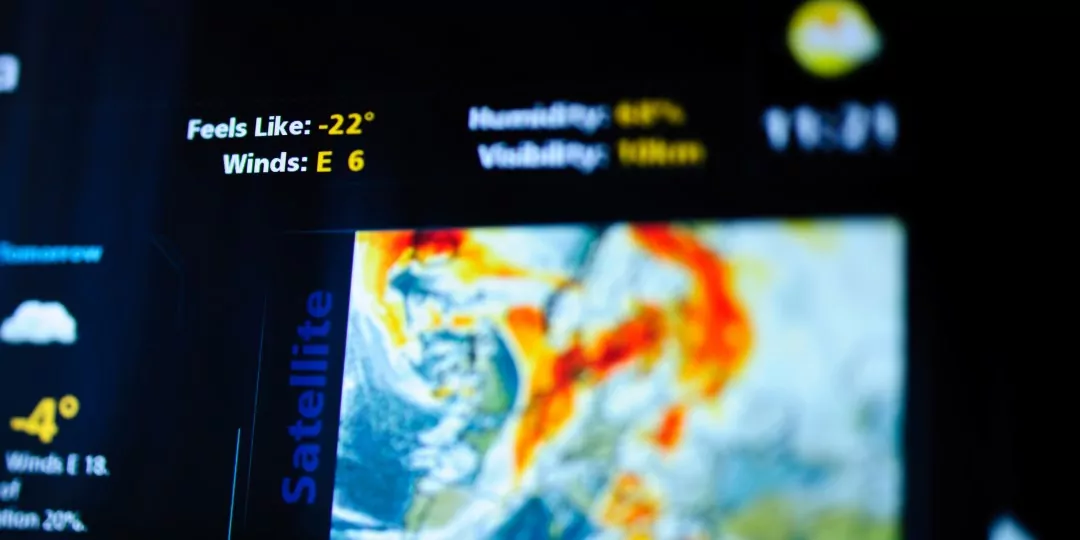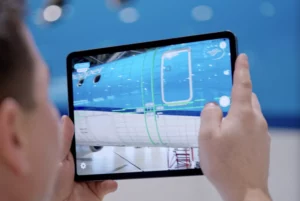
The popularity and wide use of weather forecasts has been largely attributable to the dramatic improvement in forecast accuracy. Such improvements have been quantified in recent research showing that modern 5-day weather forecasts are as accurate as 1-day forecasts in 1980. Disease forecasts are not nearly as accurate as modern weather forecasts, as documented in ongoing evaluations of COVID-19 forecast models. So, what can we learn from weather forecasting that might help us develop more robust disease forecasting and outbreak predictions?
Dr. Dylan George, head of CDCs Center for Forecasting and Outbreak Analytics (CFA) describes how disease forecasting can follow the lead of weather forecasting:
“We use weather forecasts to pre-position resources for hurricanes and to determine if we need an umbrella on a rainy day. We can use disease forecasts to determine how much vaccine we need to manufacture or if we should wear a mask that day to go out. Better data and better analytics will definitely generate better responses to health emergencies.”
As the leading provider of weather data and analytics, we at IBM believe Dr. George offers a compelling vision.
More data sources lead to greater accuracy
An explosion in the volume and variety of weather data has enabled dramatic improvements in forecast accuracy. Whereas fifty years ago, weather data was mostly confined to temperature, barometric and other readings taken at scattered weather stations, weather station data today is augmented with data from a growing network of satellites, remote sensors, radar stations, weather balloons and other sources.
Today, disease surveillance data is still largely confined to case reports from health clinics and hospitals, although the variety and volume of data has been growing. Syndromic and wastewater surveillance data are adding to traditional case reporting as a means to monitor community infection. And non-traditional data sources (like internet search trends and social media user surveys) offer the potential to obtain more real-time and hyperlocal information.
To make progress toward better disease forecasting, the volume and variety of disease surveillance data will need to continue growing. Public health investments need to focus on seeding and growing these new data sources for disease surveillance. And following the experience in weather forecasting, additional investment will be needed to harmonize these disparate data sources into a unified spacio-temporal view of community infection.
Learn more about how data strategies deliver insights to the public
Innovative modeling enables advanced disease surveillance
Advances in weather modeling and simulation—enabled by breakthroughs in machine learning and exponential growth in computing power—have been a key factor enabling improved weather forecasting. In the 1970s, weather forecasts mostly relied on numerical weather prediction methods. These days, methods are augmented with machine learning algorithms that enable accurate prediction of storm events and paths. For example, the Weather Company generates the most accurate publicly available weather forecasts, leveraging the IBM GRAF machine learning algorithms for weather prediction.
Today, disease forecasting largely relies on long-standing SIR-based—Susceptible, Infectious, Recovered—epidemiological models, although recent COVID-19 modeling has begun to incorporate more advanced machine learning algorithms, with improvements in forecast accuracy. Recent developments like the CDC’s Epidemic Prediction Initiative show promise, and the CDC CFA is investing in continued innovation to improve disease forecasting in the United States.
Continued progress in developing innovative modeling techniques will be important for achieving the vision of robust disease forecasting and outbreak predictions. Public health authorities, university researchers and private corporations can productively partner to help advance the application of advanced analytics to disease surveillance. IBM’s engagement with the Rhode Island Department of Health is a good example of what can be accomplished through public-private collaboration. IBM collaborated with RIDOH and Brown University epidemiologists to develop smart ensembles of multiple COVID-19 models for more accurate pandemic forecasts, providing 95% accuracy in forecasting the large omicron outbreak in January 2022. Our collaboration continues today with the application of machine learning to infer community infection from syndromic surveillance and wastewater surveillance data.
Modern platforms will deliver data and insights to the public
As more data and better modeling dramatically improved the accuracy of weather forecasting, a robust technology infrastructure emerged to enable high speed data processing, modeling updates and easy access to actionable insights. While weather forecasts used to be largely distributed daily through newspapers, radio and television, they’re now available on demand through the internet and mobile applications, and updated multiple times per day as conditions evolve. The ubiquity of this information enables people throughout the world to adjust plans and behaviors to minimize weather-related property damage and fatalities.
Disease forecasts, however, are not readily available to the public, as COVID-19 forecasts are only accessible on the internet to those who know where to find them. We can see the beginnings of a modern data and analytics platform to support disease surveillance, enabling automated data processing and modeling. But much progress is still needed in the public dissemination of actionable insights. One can imagine a future where infectious disease warnings are as readily available as hazardous weather warnings, enabling people to adjust plans and behaviors to minimize morbidity and mortality related to infectious disease.
To achieve that future, public health authorities need to invest in modern platforms to process data, generate actionable insights and disseminate those insights to the public. The CDC’s Data Modernization Initiative and associated grant funding to states and localities is a good start. Such funding enables public-private collaboration to jumpstart public health data modernization. A good example of a successful public-private partnership is IBM’s collaboration with Canadian and other public health authorities to develop and deploy a modern public health data platform.
Research shows that more accurate weather forecasting has saved lives and generated economic benefits exceeding required investments. Similar investments to improve the accuracy and availability of disease forecasts would also save lives and significantly reduce the economic burden of unmitigated infectious disease outbreaks.
Connect with IBM experts to unlock your data’s potential Learn more about driving data democratization with modern architecture
More from Business transformation

Will generative AI make the digital twin promise real in the energy and utilities industry?
4 min read – A digital twin is the digital representation of a physical asset. It uses real-world data (both real time and historical) combined with engineering, simulation or machine learning (ML) models to enhance operations and support human decision-making. Overcome hurdles to optimize digital twin benefits To realize the benefits of a digital twin, you need a data and logic integration layer, as well as role-based presentation. As illustrated in Figure 1, in any asset-intensive industry, such as energy and utilities, you must…
4 min read

New study reveals why mainframe application modernization is key to accelerating digital transformation
3 min read – Rapid advancement of emerging technologies—combined with the increasing demands from customers and ongoing disruptive market forces—are driving organizations to prioritize digital transformation more than ever. According to a recent survey conducted by the IBM Institute for Business Value in cooperation with Oxford Economics, 67% percent of executive respondents say their organizations need to transform quickly to keep up with the competition, while 57% report current market disruptions are placing unprecedented pressure on their IT.1 Digital transformation places significant demands on…
3 min read

Central Bank Digital Currency (CBDC) and blockchain enable the future of payments
4 min read – The financial world has been revolutionized by blockchain technology, which has enabled peer-to-peer transactions without the need for intermediaries. The introduction of Central Bank Digital Currency (CBDC) has added a new dimension to blockchain technology that transforms the future of payments for businesses and individuals. Some time ago, banks and governments started shifting their attention towards using digital assets in their operations and economies. The executive order from the President of the United States, “Responsible Development of Digital Assets,” is…
4 min read

Take advantage of AI and use it to make your business better
7 min read – Artificial intelligence (AI) adoption is here. Organizations are no longer asking whether to add AI capabilities, but how they plan to use this quickly emerging technology. In fact, the use of artificial intelligence in business is developing beyond small, use-case specific applications into a paradigm that places AI at the strategic core of business operations. By offering deeper insights and eliminating repetitive tasks, workers will have more time to fulfill uniquely human roles, such as collaborating on projects, developing innovative…
7 min read
- SEO Powered Content & PR Distribution. Get Amplified Today.
- PlatoData.Network Vertical Generative Ai. Empower Yourself. Access Here.
- PlatoAiStream. Web3 Intelligence. Knowledge Amplified. Access Here.
- PlatoESG. Automotive / EVs, Carbon, CleanTech, Energy, Environment, Solar, Waste Management. Access Here.
- PlatoHealth. Biotech and Clinical Trials Intelligence. Access Here.
- ChartPrime. Elevate your Trading Game with ChartPrime. Access Here.
- BlockOffsets. Modernizing Environmental Offset Ownership. Access Here.
- Source: https://www.ibm.com/blog/three-lessons-from-weather-forecasting-that-will-improve-disease-forecasting-and-outbreak-prediction/
- :has
- :is
- :not
- :where
- $UP
- 1
- 11
- 15%
- 17
- 2022
- 2023
- 22
- 26
- 28
- 30
- 300
- 39
- 46
- 9
- 95%
- a
- About
- accelerating
- access
- accessible
- accomplished
- According
- accuracy
- accurate
- Achieve
- achieving
- add
- added
- adding
- Additional
- adjust
- Adoption
- advance
- advanced
- advancement
- ADvantage
- Advertising
- ago
- AI
- algorithms
- All
- also
- Although
- amp
- an
- analytics
- and
- any
- Application
- applications
- ARE
- article
- artificial
- artificial intelligence
- AS
- asset
- Assets
- associated
- At
- attention
- augmented
- AUGUST
- author
- Authorities
- Automated
- availability
- available
- back
- Bank
- Banks
- BE
- been
- begun
- believe
- benefits
- Better
- Beyond
- Big
- Big Data
- blockchain
- blockchain technology
- Blog
- both
- breakthroughs
- Brown University
- burden
- business
- business operations
- Business Transformation
- businesses
- but
- by
- CAN
- Canadian
- capabilities
- carbon
- card
- Cards
- case
- CAT
- CBDC
- CDC
- Center
- central
- Central Bank
- central bank digital currency
- central bank digital currency (CBDC)
- cfa
- check
- City
- class
- CMU
- code
- collaborated
- collaborating
- collaboration
- color
- combined
- Communication
- community
- company
- compelling
- competition
- computing
- concept
- conditions
- conducted
- Container
- continue
- continued
- continues
- cooperation
- Core
- Corporations
- COVID-19
- CSS
- Currency
- Current
- custom
- Customers
- daily
- damage
- data
- Data Platform
- data processing
- Date
- day
- Days
- Decision Making
- deeper
- Default
- definitely
- definitions
- deliver
- demands
- democratization
- Department
- deploy
- description
- Determine
- develop
- developing
- Development
- developments
- digital
- Digital Assets
- digital currency
- Digital Transformation
- digital twin
- Dimension
- Disease
- disparate
- disruptions
- disruptive
- distributed
- documented
- dr
- dramatic
- dramatically
- driving
- easy
- Economic
- Economics
- economies
- eliminating
- emerged
- emerging
- Emerging Technology
- enable
- enabled
- enables
- enabling
- energy
- engagement
- Engineering
- enhance
- Enter
- Ether (ETH)
- events
- EVER
- evolve
- example
- executive
- executive order
- Exit
- experience
- experts
- explosion
- exponential
- Exponential Growth
- fact
- factor
- fatalities
- fifty years
- Figure
- financial
- Find
- Focus
- follow
- following
- fonts
- For
- Forecast
- forecasts
- from
- Fulfill
- funding
- future
- Future of Payments
- generate
- generated
- generates
- generative
- Generative AI
- generator
- George
- Go
- good
- Governments
- grant
- greater
- Grid
- Growing
- Growth
- Have
- head
- Health
- height
- help
- here
- High
- historical
- hospitals
- How
- However
- HTML
- HTTPS
- human
- Hurdles
- IBM
- ICO
- ICON
- if
- image
- imagine
- important
- improve
- improved
- improvement
- improvements
- in
- incorporate
- increasing
- index
- individuals
- industry
- infection
- information
- Infrastructure
- Innovation
- innovative
- insights
- Institute
- integration
- Intelligence
- intermediaries
- Internet
- into
- Introduction
- Invest
- investing
- investment
- Investments
- island
- IT
- January
- jpg
- Keep
- Key
- key factor
- Know
- large
- largely
- layer
- lead
- LEARN
- learning
- Lessons
- leveraging
- like
- Lives
- locale
- logic
- long-standing
- longer
- looking
- machine
- machine learning
- make
- mark
- Market
- mask
- max-width
- means
- Media
- methods
- might
- min
- minutes
- MIT
- ML
- Mobile
- Mobile Applications
- modeling
- models
- Modern
- modernization
- Monitor
- more
- most
- mostly
- much
- multiple
- Navigation
- nearly
- Need
- needed
- network
- New
- Newspapers
- night
- no
- nothing
- obtain
- of
- offer
- offering
- Offers
- on
- ONE
- ongoing
- only
- Operations
- Optimize
- optimized
- or
- order
- organizations
- Other
- our
- out
- outbreak
- Overcome
- Oxford
- page
- pandemic
- paradigm
- partner
- Partnership
- payments
- peer to peer
- Peer-to-Peer Transactions
- People
- people throughout
- per
- percent
- PHP
- physical
- Places
- placing
- plan
- plans
- platform
- Platforms
- plato
- Plato Data Intelligence
- PlatoData
- plugin
- policy
- popularity
- position
- Post
- potential
- prediction
- Predictions
- presentation
- president
- pressure
- Prioritize
- private
- process
- processing
- Progress
- projects
- promise
- property
- provider
- providing
- public
- public health
- publicly
- quickly
- radar
- Radio
- Reading
- real
- real world
- real-time
- realize
- recent
- reduce
- related
- remote
- repetitive
- report
- Reporting
- Reports
- representation
- required
- researchers
- Resources
- respondents
- responses
- responsive
- Reveals
- revolutionized
- robots
- robust
- roles
- satellites
- Save
- say
- scattered
- Screen
- scripts
- Search
- see
- sensors
- seo
- SHIFTING
- should
- show
- showing
- Shows
- significant
- significantly
- similar
- simulation
- site
- small
- smart
- So
- Social
- social media
- some
- Sources
- specific
- speed
- Sponsored
- start
- started
- States
- station
- Stations
- Still
- Storm
- Strategic
- strategies
- Study
- successful
- such
- support
- surveillance
- Survey
- Take
- taken
- tasks
- techniques
- Technology
- technology infrastructure
- television
- than
- that
- The
- The Future
- the world
- their
- Them
- theme
- These
- they
- this
- those
- three
- Through
- throughout
- time
- times
- Title
- to
- today
- top
- toward
- towards
- traditional
- Transactions
- Transform
- Transformation
- transforms
- Trends
- twin
- type
- umbrella
- unified
- uniquely
- United
- United States
- university
- unlock
- unmitigated
- unprecedented
- updated
- Updates
- URL
- us
- use
- used
- User
- uses
- using
- utilities
- Vaccine
- value
- variety
- Video
- View
- vision
- volume
- W
- Wall
- was
- we
- Weather
- WELL
- What
- whereas
- whether
- which
- while
- WHO
- why
- wide
- will
- with
- without
- woman
- WordPress
- workers
- world
- would
- written
- XML
- years
- you
- Your
- zephyrnet












